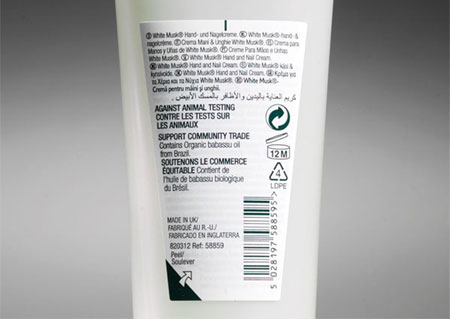Read the label before you buy
Did you know that there are no regulations for safety testing on cosmetic products, and while some products may claim to be "natural" or "gentle" there really is no standard for these claims.
How to read a label
Every personal care product must list its ingredients. Here's how to navigate the label:
- Start at the end, with preservatives. Avoid:
- Words ending in "paraben"
- DMDM hydantoin
- Imidazolidinyl urea
- Methylchloroisothiazolinone
- Methylisothiazolinone
- Triclosan
- Triclocarban
- Triethanolamine (or "TEA")
- Check the beginning of the ingredients lists, where soaps, surfactants, and lubricants show up. Try to avoid ingredients that start with "PEG" or have an "-eth" in the middle (e.g., sodium laureth sulfate).
- Read the ingredients in the middle. Look for these words: "FRAGRANCE," "FD&C," or "D&C."
Extra caution is in order for kids because they are exposed to more contaminants in everyday products than adults. Their immature metabolism and organ systems are typically less capable of fending off chemical assaults. Even subtle damage to young bodies can lead to disease later in life.
Follow these top five tips for kids:
- Use fewer products and use them less often.
- Don't trust ad hype. Check ingredients.
- Buy fragrance-free products.
- Avoid the use of baby powder.
- Always avoid the top six chemicals of concern for kids:
- 2-Bromo-2-Nitropropane-1,3 Diol
- BHA
- Boric acid and sodium borate
- DMDM Hydantoin
- Oxybenzone
- Triclosan
Here are some safe shopping tips which will help us to avoid products that may harm us:
- Use fewer products. Is there something you can cut from your daily routine, or a product you can use less often? By cutting down on the number of chemicals contacting your skin every day, you will reduce any potential health risks associated with your products.
- Read labels. Marketing claims on personal care products are not defined under the law, and can mean anything or nothing at all, including claims like organic, natural, hypoallergenic, animal cruelty free, and fragrance free. Read the ingredient label carefully to find evidence that the claims are true.
- Use milder soaps. Soap removes dirt and grease from the surface of your skin, but also strips away your body's own natural skin oils. Choosing a
milder soap may reduce skin dryness and your need for moisturizers to replace oils your skin can provide naturally.
- Minimize your use of dark hair dyes. Many contain coal tar ingredients that have been linked to cancer in some studies.
- Cut down on your use of powders; avoid the use of baby powder on newborns and infants. A number of ingredients common in powder have been linked to cancer and other lung problems when they are inhaled.
- Choose products that are "fragrance"-free. Fragrances can cause allergic reactions. Products that claim to be "fragrance free" on the packaging may not be. They could contain masking fragrances that give off a neutral odour. Read the ingredient label — in products truly free of fragrance, the word "fragrance" will not appear there.
- Reduce your use of nail polish. It's one of the few types of products that routinely contains ingredients linked to birth defects. Paint your toenails and skip the fingernails. Paint nails in a well-ventilated room, or outside, or avoid using nail polish altogether, particularly when you are pregnant.
oomphorganic.com

